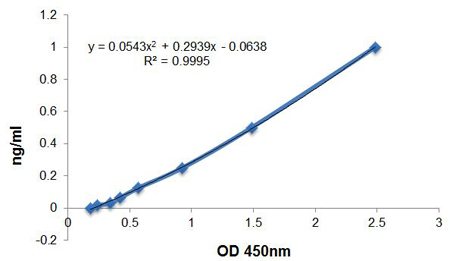Zinc-alpha-2-glycoprotein (human) Matched Pair Detection Set
Product Code:
AG-46B-0008
AG-46B-0008
Host Type:
Human
Human
Regulatory Status:
RUO
RUO
Target Species:
Human
Human
Application:
Enzyme-Linked Immunosorbent Assay (ELISA)
Enzyme-Linked Immunosorbent Assay (ELISA)
Shipping:
Blue Ice
Blue Ice
Storage:
-20°C
-20°C
No additional charges, what you see is what you pay! *
| Code | Size | Price |
|---|
| AG-46B-0008-KI01 | 1 Set | £570.00 |
Quantity:
Prices exclude any Taxes / VAT
Stay in control of your spending. These prices have no additional charges, not even shipping!
* Rare exceptions are clearly labelled (only 0.14% of items!).
* Rare exceptions are clearly labelled (only 0.14% of items!).
Multibuy discounts available! Contact us to find what you can save.
This product comes from: Switzerland.
Typical lead time: 7-10 working days.
Contact us for more accurate information.
Typical lead time: 7-10 working days.
Contact us for more accurate information.
- Further Information
- Documents
- Show All
Further Information
Alternate Names/Synonyms:
Zn-alpha-2-GP; Zn-alpha-2-Glycoprotein; ZAG; ZA2G; AZGP1; ZNGP1
Assay Type:
Sandwich
Detection Type:
Colorimetric
EClass:
32160000
Handling Advice:
Avoid freeze/thaw cycles.
Kit Contains:
1 vial standard protein (1µg) (lyophilized) [STD] | 1 vial coating antibody (120µl) [COAT] | 1 vial detection antibody (60µl) [DET] | 1 vial streptavidin-HRP (10µg) (lyophilized) [STREP]
Long Description:
Matched Pair Detection Set. Detects human Zinc-alpha-2-glycoprotein. Does not detect mouse Zinc-alpha-2-glycoprotein. Colorimetric assay. Sample Type: Cell Culture Supernatant, Plasma, Serum. Range: 0.0156 to 1 ng/ml. Sensitivity: 100 pg/ml. Zinc-alpha-2-glycoprotein (ZAG), first identified in the 1960s, derives its name from its precipitation from human plasma upon the addition of zinc salts. ZAG has since been found in secretory epithelial cells and in a range of body fluids. ZAG is identical to a lipid mobilizing factor isolated from the urine of patients with cancer cachexia and stimulates lipolysis in in vitro and in vivo experiments. Due to its expression in, and secretion from adipocytes, ZAG is considered an adipokine. Recently the clinical significance of ZAG has been clarified. ZAG expression in adipocytes is inversely related to fat mass, thus it is intimately involved in the maintenance of body weight in mice and humans. Epidemiological studies have uncovered an association between ZAG and plasma cholesterol. The non-synonymous single nucleotide polymorphism rs4215 in ZAG is associated with plasma cholesterol and obesity. Structurally ZAG possesses a class I major histocompatibility complex (MHC) protein fold. It is distinct from other members of this protein family in that it is soluble, rather than being anchored to plasma membranes, and it associates with prolactin inducible protein rather than beta2-microglobulin. Similar to peptide antigen-presenting class I MHC molecules, ZAG possesses an open apical groove between its alpha1 and alpha2 domain helices.
Package Type:
Box
Product Description:
Zinc-alpha-2-glycoprotein (ZAG), first identified in the 1960s, derives its name from its precipitation from human plasma upon the addition of zinc salts. ZAG has since been found in secretory epithelial cells and in a range of body fluids. ZAG is identical to a lipid mobilizing factor isolated from the urine of patients with cancer cachexia and stimulates lipolysis in in vitro and in vivo experiments. Due to its expression in, and secretion from adipocytes, ZAG is considered an adipokine. Recently the clinical significance of ZAG has been clarified. ZAG expression in adipocytes is inversely related to fat mass, thus it is intimately involved in the maintenance of body weight in mice and humans. Epidemiological studies have uncovered an association between ZAG and plasma cholesterol. The non-synonymous single nucleotide polymorphism rs4215 in ZAG is associated with plasma cholesterol and obesity. Structurally ZAG possesses a class I major histocompatibility complex (MHC) protein fold. It is distinct from other members of this protein family in that it is soluble, rather than being anchored to plasma membranes, and it associates with prolactin inducible protein rather than beta2-microglobulin. Similar to peptide antigen-presenting class I MHC molecules, ZAG possesses an open apical groove between its alpha1 and alpha2 domain helices.
Range:
0.0156 to 1 ng/ml
Sample Type:
Cell Culture Supernatant, Plasma, Serum
Sensitivity:
100 pg/ml
Specificity:
Detects human Zinc-alpha-2-glycoprotein. Does not detect mouse Zinc-alpha-2-glycoprotein.
Transportation:
Non-hazardous
UNSPSC Category:
ELISA Kits
UNSPSC Number:
41116126
Use & Stability:
Stable for at least 1 year after receipt when stored at -20°C.



